Everest Teahouse Trek, Nepal
October / November 2007
|
| Index | Click
on an image to enlarge it (JavaScript is required). |
Sunday 28th & Monday 31st October 2007
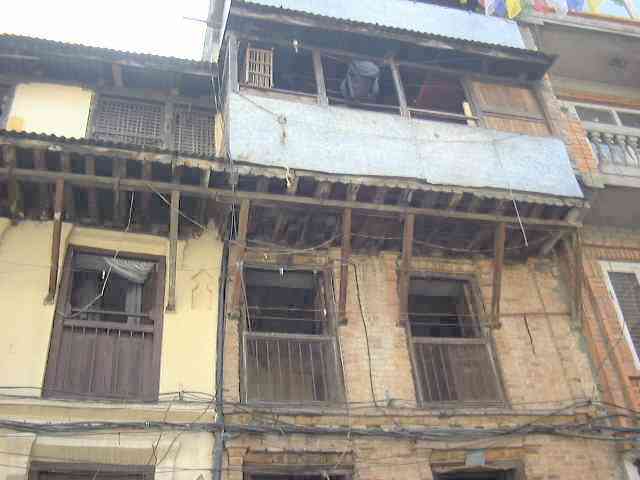 After
24 hours of airports and aeroplanes we finally reach Kathmandu. The
airport is our first taste of chaos as no one had bothered to chalk the
flight numbers onto the chalkboards over the baggage carousels. Outside
the air was warm and smelly and the sun was going down through the haze.
In the other direction the tops of the Himalayas could just be seen
through the thick air. We clamber into the minibus that is waiting for us
while our baggage is pushed through the window then we set off into
Kathmandu city. After
24 hours of airports and aeroplanes we finally reach Kathmandu. The
airport is our first taste of chaos as no one had bothered to chalk the
flight numbers onto the chalkboards over the baggage carousels. Outside
the air was warm and smelly and the sun was going down through the haze.
In the other direction the tops of the Himalayas could just be seen
through the thick air. We clamber into the minibus that is waiting for us
while our baggage is pushed through the window then we set off into
Kathmandu city.
Kathmandu is like any other Asian city I have been to with the buildings
either halfway complete or gently decaying relics. Everything is covered
in a thick layer of grime. Some houses do not seem to have glass in their
windows but inside a family is watching television. In the street, a
barber has no shop, just a chair in front of a mirror on a stand in a
dusty patch of ground. The streets are awash with bicycles, motorcycles,
cars, buses, vans, people, dogs and cows! There appear to be no rules on
the road apart from toot your horn if anything gets in your way. We
finally turned into our hotel for the next 2 nights. It looked like it
could have been quite a nice place, once. Hotel
Mountain.
Our group consisted of 9 people; Jon, John and Hilary, Peter and Virginia,
Geraldine, and Julia. We had met on the plane and in the bus but we first
started to get to know the whole group in the Princes Bar of the hotel. We
ate, drank then crashed.
|
Tuesday 30th October 2007
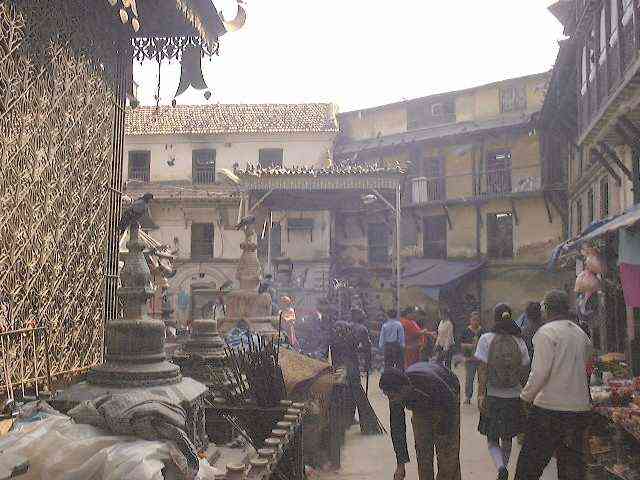 After
a breakfast of vegetable curry and chapatti we set off for a walking tour
of the tourist hot spots. We walked down many crowded streets of rubble
and dust, lined with tiny shops each specialising in one thing or another.
The smells in the air changed with each shop we passed; from spices to raw
meat, to incense then cow poo. After
a breakfast of vegetable curry and chapatti we set off for a walking tour
of the tourist hot spots. We walked down many crowded streets of rubble
and dust, lined with tiny shops each specialising in one thing or another.
The smells in the air changed with each shop we passed; from spices to raw
meat, to incense then cow poo.
There were many temples on the way for people to pray at. One temple in
the middle of a square had strings of prayer flags strung from the tops of
the surrounding buildings in to the top of the temple. Another had bowls
of fire in each corner for people to stir in a clockwise direction,
apparently to dissipate their anger. All around, hundreds of pigeons
swarmed, feeding on the grain scattered about for them.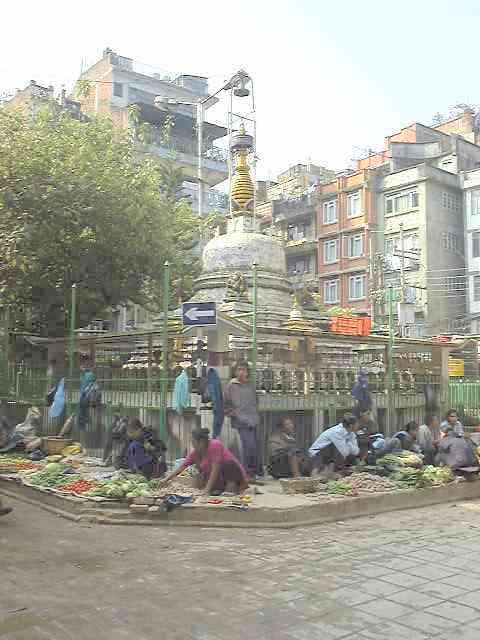 Occasionally they would get spooked and the air would be filled with
franticly flapping wings. Inside the temple, behind a gate and across a
passage was a shrine with a Buddha so that worshipers would have to throw
their offerings at their deity.
Occasionally they would get spooked and the air would be filled with
franticly flapping wings. Inside the temple, behind a gate and across a
passage was a shrine with a Buddha so that worshipers would have to throw
their offerings at their deity.
The kings old palace is now a museum and open to tourists. Among the
temples and pagodas the living goddess resides in her top floor apartment.
While we were in the courtyard she graced us with an appearance at her 2nd
floor window. I have never seen a living goddess but I did not expect the
teenager attitude and chewing gum.
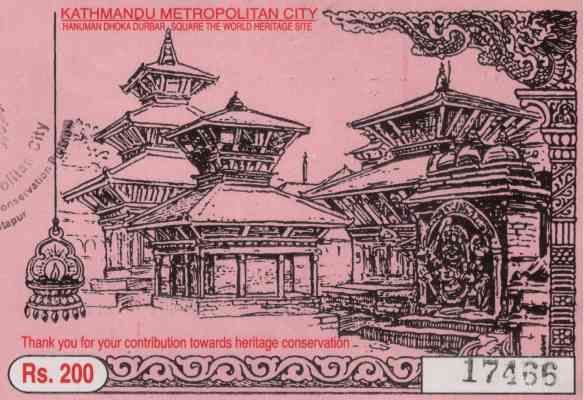 Pagodas
were apparently invented in Nepal and adopted by the Chinese and Indians,
or so said our guide. Pagodas
were apparently invented in Nepal and adopted by the Chinese and Indians,
or so said our guide.
Our next stop was the equipment hire shop where we picked up down jackets
and 4 seasons sleeping bags for our impending trek into the mountains.
From there we went to a nearby restaurant for lunch where I had trouble
finding a Nepalese dish in amongst the international selections.
In the afternoon we repacked our gear into kit bags for the trek and then
went for tea in another non-Nepalese style bar and restaurant. After what
seemed like no time at all, we were setting out across town for dinner.
The streets appeared so much different when lit only by the shop
advertising signs. By the time we left the restaurant at about 9 p.m. the
street traffic was down to almost manageable proportions.
|
Wednesday 31st October 2007
It was har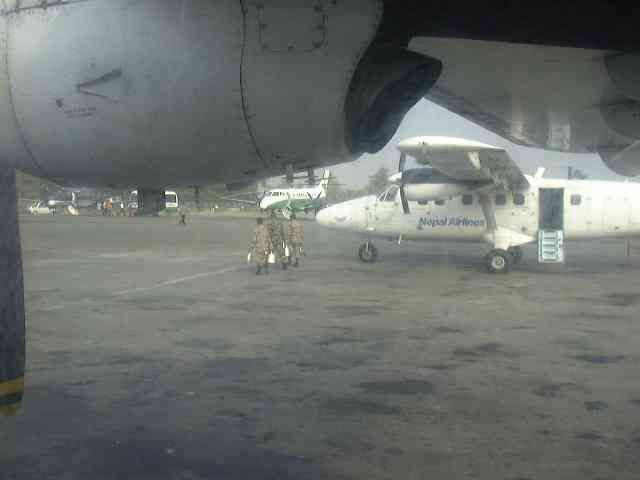 dly
worth going to sleep as we had to be up at 4.45 a.m. to set off for the
airport. dly
worth going to sleep as we had to be up at 4.45 a.m. to set off for the
airport. 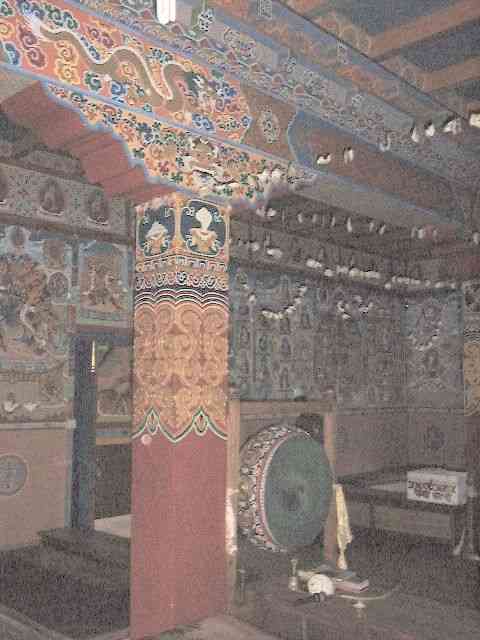 The
little 16-seated aircraft can only make the half hour flight from
Kathmandu to Lukla if there is at least 3km of visibility at both ends. We
had to wait till about 9 a.m. and then a flurry of small aeroplanes and
helicopters started taking off. Our little plane flew up over terraced
fields and sparkling rivers, then through gaps in the mountains and along
valleys until we turned a corner to see Lukla airstrip running up the side
of the mountain. We were still flying upwards as the ground rushed up to
meet us but the up hill roll meant we stopped just in time to avoid the
brick wall at the end of the strip. There was only parking enough for 4
small aeroplanes so no sooner had we disembarked than others climbed
aboard and the little plane rushed back down the short airstrip and out
into the abyss. The
little 16-seated aircraft can only make the half hour flight from
Kathmandu to Lukla if there is at least 3km of visibility at both ends. We
had to wait till about 9 a.m. and then a flurry of small aeroplanes and
helicopters started taking off. Our little plane flew up over terraced
fields and sparkling rivers, then through gaps in the mountains and along
valleys until we turned a corner to see Lukla airstrip running up the side
of the mountain. We were still flying upwards as the ground rushed up to
meet us but the up hill roll meant we stopped just in time to avoid the
brick wall at the end of the strip. There was only parking enough for 4
small aeroplanes so no sooner had we disembarked than others climbed
aboard and the little plane rushed back down the short airstrip and out
into the abyss.
After cups of sweet milky tea we walked down Lukla main street past its
little shops, rocky path and yak poo and down to the monastery. The monks
were not much in evidence but a couple of children opened the doors to let
us in. Inside, the style was very much like temples we had seen in
Thailand with red and gold painted dragons and Buddha. Next-door there was
a school where young monks learned how to paint monasteries.
We walked back past ‘the children who know how to say chocolate’
and on up to the hospital where all the unsuccessful climbers end up.
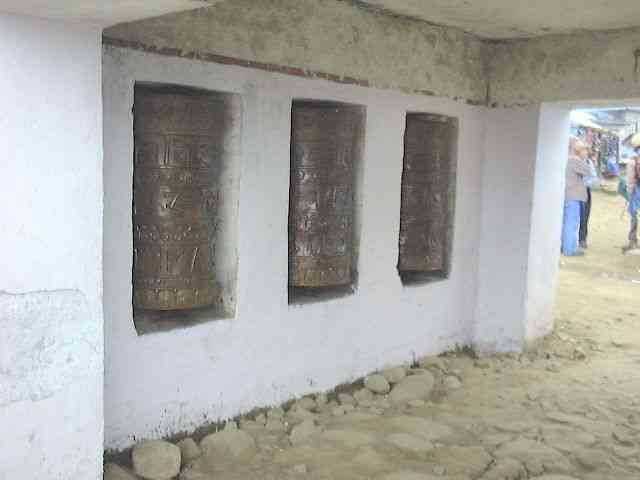 After
a fine lunch provided by our guides, we set out for Pakding where we would
stay our first night in a teahouse. We had 4 guides to take care of the 9
of us and more must have gone ahead with the Yaks bearing our luggage. The
path varied between carefully laid rocks, boulders and rubble, so the
going was slow. A steady stream of traffic passed both ways including
other trekkers, yaks and porters carrying loads larger than themselves.
The porters bore the weight via a strap over their heads. No wonder they
are all small. After
a fine lunch provided by our guides, we set out for Pakding where we would
stay our first night in a teahouse. We had 4 guides to take care of the 9
of us and more must have gone ahead with the Yaks bearing our luggage. The
path varied between carefully laid rocks, boulders and rubble, so the
going was slow. A steady stream of traffic passed both ways including
other trekkers, yaks and porters carrying loads larger than themselves.
The porters bore the weight via a strap over their heads. No wonder they
are all small.
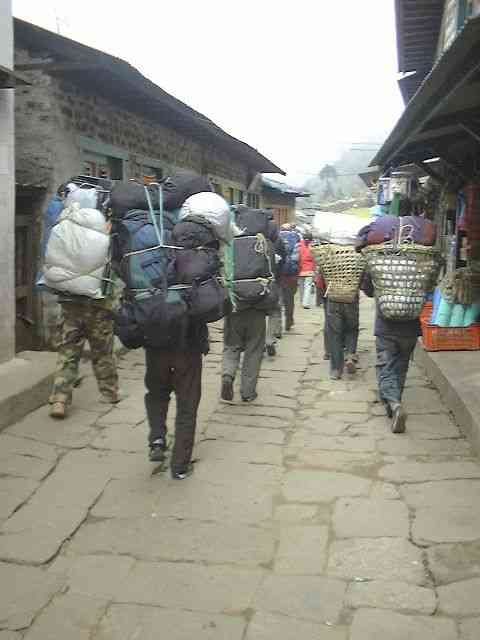 I
have been referring to the pack animals as yaks for convenience but they
are actually a cross between a yak and a cow, having shorter hair and
backward pointing horns, called a Jockpe or Khainag or Dimjo. I
have been referring to the pack animals as yaks for convenience but they
are actually a cross between a yak and a cow, having shorter hair and
backward pointing horns, called a Jockpe or Khainag or Dimjo.
Despite the low cloud the views were wonderful of tree lined valleys
containing white water rivers. The trees were mostly pine but with soft
needles. We walked over suspension bridges, which seemed wobbly until I
realised that fully laden yaks walked over then with ease, so it was
probably just me.
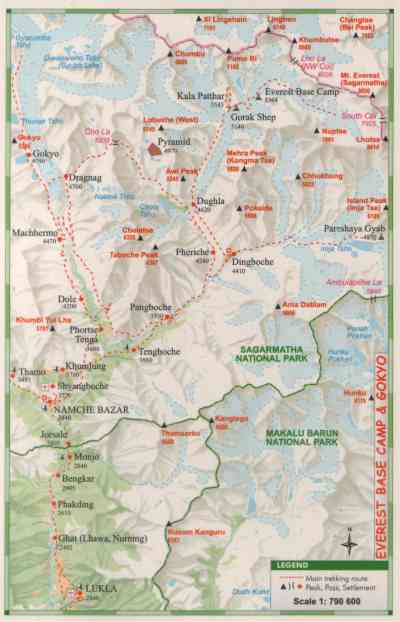 After
3 or 4 hours walk we came to ‘Namaste Teahouse’ for our first
overnight stop. ‘Namaste’ means ‘good day’ and is the most
frequently used word we will hear the entire trip. Like many of the other
houses it is built of rough and cut stones with a corrugated steel roof
and chunky wooden window frames. Inside it is roughly panelled in wood
although some of the panels fall a bit short. There is a brazier in the
dining room and a flue that runs up through the hallways past the rooms
but there is no other heating. As the cool night air breezes through the
cracks we realise why we need 4 season sleeping bags. After
3 or 4 hours walk we came to ‘Namaste Teahouse’ for our first
overnight stop. ‘Namaste’ means ‘good day’ and is the most
frequently used word we will hear the entire trip. Like many of the other
houses it is built of rough and cut stones with a corrugated steel roof
and chunky wooden window frames. Inside it is roughly panelled in wood
although some of the panels fall a bit short. There is a brazier in the
dining room and a flue that runs up through the hallways past the rooms
but there is no other heating. As the cool night air breezes through the
cracks we realise why we need 4 season sleeping bags.
Dinner was made by our assistant guides and was a good, simple fare of
carrots, fried potato and cabbage, or pok choi seem to be the staple. I
went to bed early with a headache, which was probably altitude sickness.
This was disappointing because we were only at 2600m.
|
Thursday 1st November 2007
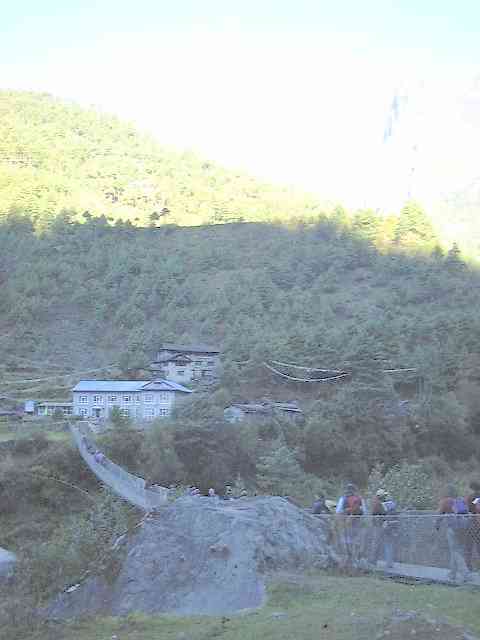 By
the morning m By
the morning m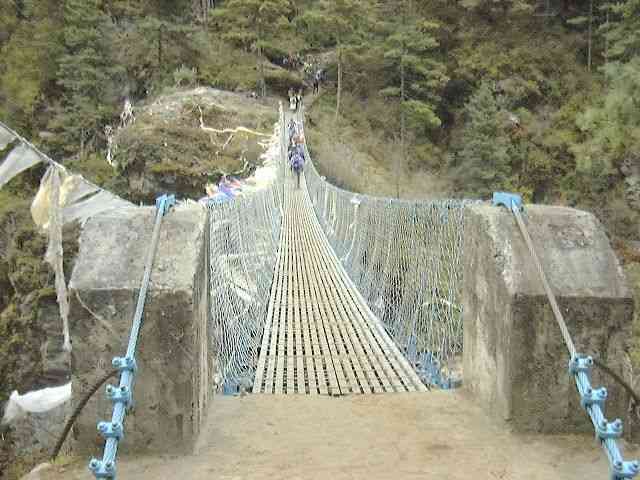 y
headache was just a dull numbness and I resolved to drink more water. At
breakfast we spoke to some walkers coming down from Everest base camp, who
told us to drink 6 litres per day on the way up. This was disheartening as
I hate drinking plain water but our guides provided boiled water, which
was nicer to drink. I drunk water whenever I felt a headache coming on but
still never managed to finish even 1 litre of plain water a day.
Fortunately I never got a bad headache again anyway. y
headache was just a dull numbness and I resolved to drink more water. At
breakfast we spoke to some walkers coming down from Everest base camp, who
told us to drink 6 litres per day on the way up. This was disheartening as
I hate drinking plain water but our guides provided boiled water, which
was nicer to drink. I drunk water whenever I felt a headache coming on but
still never managed to finish even 1 litre of plain water a day.
Fortunately I never got a bad headache again anyway.
The morning trek was quite easy going, rising by only 200 metres, although
there were many ups and downs and much of the path was just boulders. A
milky blue river of glacier melt ran along side our path, tumbling and
rolling over huge boulders in its path. Our route ran back and forth
across it by means of wobbly suspension bridges. Curiously, many, many
prayer flags adorned these suspension bridges, as if prayer were
necessary. Through gaps in the near, tree covered mountains, we get
glimpses of a distant, snow capped mountain, possibly Thamserku or
Kangtega.
We stopped for lunch on a sunny balcony at a restaurant in Jorsale before
setting off for the gruelling afternoon ascent of 700 metres to Namche
Bazar at 3440 metres. The rocky path just kept going up and up for hours
on end. Despite this it was a popular track with many trekkers and
porters. The porters put the trekkers to shame by carrying loads twice
their own size. 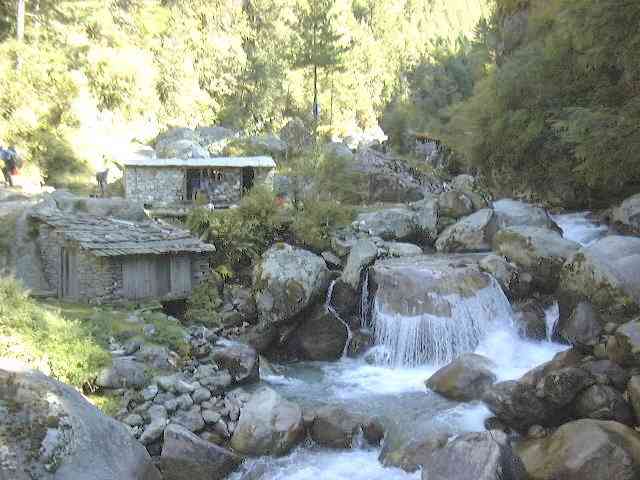 The
clouds came down as we ascended but fortunately we walked into Namche
Bazar before the cloud enveloped it. The
clouds came down as we ascended but fortunately we walked into Namche
Bazar before the cloud enveloped it.
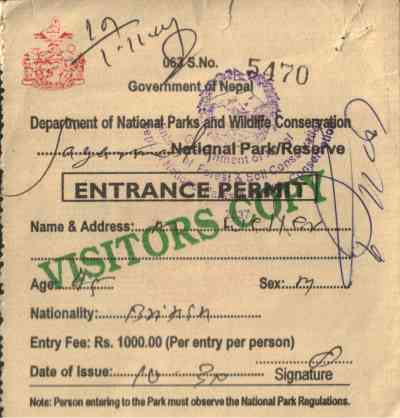 Namche
is quite a large village nestling in a bowl shaped valley with a couple of
fields on the lower slopes. The fields were filled with a market which had
come all the way from Tibet over 5000 metre high passes and taking 5 or
more days to walk. There were not so much market stalls as market
tarpaulins with wares spread out over them, mostly cloths. Other
tarpaulins were fashioned into tents where it appeared the traders cooked
and slept overnight. Namche
is quite a large village nestling in a bowl shaped valley with a couple of
fields on the lower slopes. The fields were filled with a market which had
come all the way from Tibet over 5000 metre high passes and taking 5 or
more days to walk. There were not so much market stalls as market
tarpaulins with wares spread out over them, mostly cloths. Other
tarpaulins were fashioned into tents where it appeared the traders cooked
and slept overnight.
There are about 60 lodges in Namche, the number increasing over recent
years as tourism increased. We were staying at the Thamserku View Lodge,
which was quite a nice place with varnished wooden panelling inside and
fewer gaps to let in the cold. Despite this it was still cold as there was
no heating apart from a small electric heater in the common room and the
‘yak pat’ burning cooking range in the kitchen. Interestingly there
was a shower room inside (there were also 2 outside but no mention of hot
water) so we decided to splash out NR150 and wash before dinner. This
turned out to be a mistake because it was like taking a hot shower in an
ice-box. As soon as the shower stopped everything froze.
Dinner was greatly appreciated as it started with hot garlic and noodle
soup which warmed us up nicely. Tonight was Tracy’s turn for an altitude
sickness headache. My head was not right either so we retired early to bed
again.
|
Friday 2nd November 2007
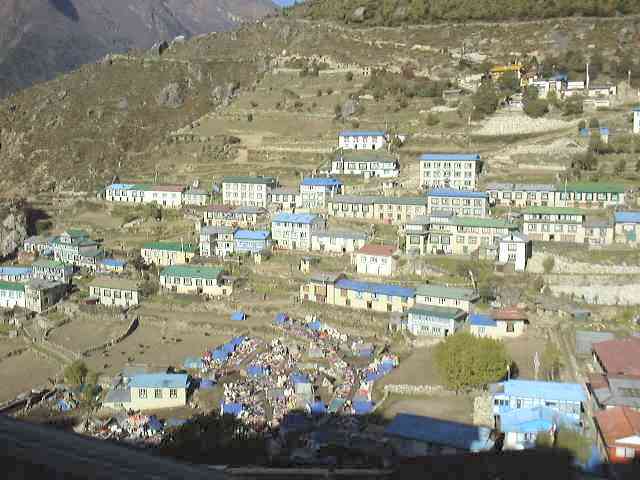 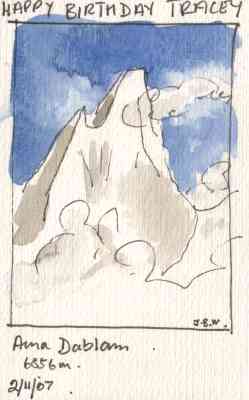 It
is hard to prize yourself out of a warm sleeping bag into a cold room,
even if breakfast is waiting for you downstairs. Tikendra (our guide) had
warned us off alcohol whilst we were in high altitude so Tracy had
mentioned the night before that it would be a dry birthday. John, our
resident artist, had heard this and painted a card of a local mountain,
Ama Dablam, which everyone had signed. It made a good start to her
birthday. Today would be an acclimatization day so we would walk up a few
hundred metres and back to stay at the same lodge. Our first walk took us
to a viewpoint where we could just see the peak of Everest between the
local peaks. When we set off it was cold but by the time we got there the
sun had risen above the mountains and warmed the place nicely. The sky was
blue and the air still and it was really, really peaceful just sitting
there, looking at the landscape and listening to the crows craw. Also
camped on this peaceful peak were the Nepalese military with a few
buildings and lots of trenches. It was hard to imagine what they were
defending apart from a mobile phone mast and a satellite dish. One of the
buildings was an interesting museum which we spent some time in before
walking down the hill to see an example of a traditional house with a
prayer room and living room stuffed full of museum artefacts. By the
stairs at the front door was a complete wall made from dried yak-pats,
collected, dried in the sun and stored for fuel. It
is hard to prize yourself out of a warm sleeping bag into a cold room,
even if breakfast is waiting for you downstairs. Tikendra (our guide) had
warned us off alcohol whilst we were in high altitude so Tracy had
mentioned the night before that it would be a dry birthday. John, our
resident artist, had heard this and painted a card of a local mountain,
Ama Dablam, which everyone had signed. It made a good start to her
birthday. Today would be an acclimatization day so we would walk up a few
hundred metres and back to stay at the same lodge. Our first walk took us
to a viewpoint where we could just see the peak of Everest between the
local peaks. When we set off it was cold but by the time we got there the
sun had risen above the mountains and warmed the place nicely. The sky was
blue and the air still and it was really, really peaceful just sitting
there, looking at the landscape and listening to the crows craw. Also
camped on this peaceful peak were the Nepalese military with a few
buildings and lots of trenches. It was hard to imagine what they were
defending apart from a mobile phone mast and a satellite dish. One of the
buildings was an interesting museum which we spent some time in before
walking down the hill to see an example of a traditional house with a
prayer room and living room stuffed full of museum artefacts. By the
stairs at the front door was a complete wall made from dried yak-pats,
collected, dried in the sun and stored for fuel.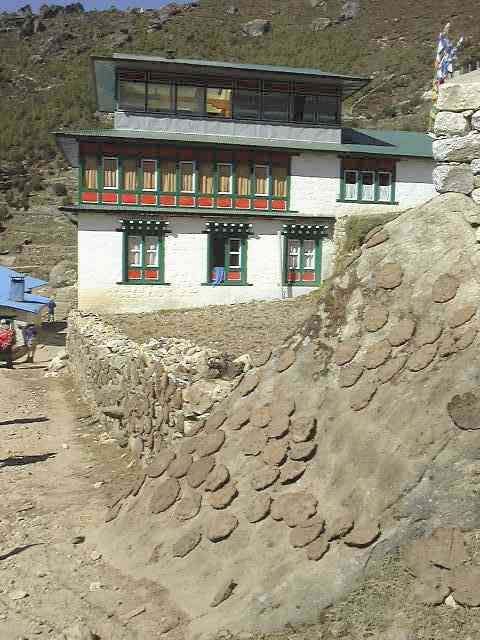
As we walked back down to the town we began to notice all the yak-pats
stuck to rocks and walls and knew that it was not just a yak bowel
problem. Below us the town was laid out in a bowl like valley in the side
of the mountain. In the last couple of decades it had expanded massively
to accommodate the increase of tourists from about 1400 in the 1980s to
25000 at the turn of the century. This increase in tourist trade was
fortunate for the town when the Chinese took over Tibet and restricted
their trade with the Tibetans.
The food at the lodge was really good so we were all glad to go back there
for lunch, after which we took another walk, this time along the main path
to Tibet. .jpg) There
were quite a few Tibetans on this path carrying their wares to Namche
Bazar so I guess the Nepalese had not restricted the trade from Tibet. We
could tell that they were Tibetan they had more Chinese features than the
Nepalese and some wore big blue ear rings. At one point there was a yak
traffic jam as trains from both directions tried to squeeze past on the
narrow path. The views down into the steep valley were spectacular with
kilometre long waterfalls down to the milky blue river running along the
bottom. There
were quite a few Tibetans on this path carrying their wares to Namche
Bazar so I guess the Nepalese had not restricted the trade from Tibet. We
could tell that they were Tibetan they had more Chinese features than the
Nepalese and some wore big blue ear rings. At one point there was a yak
traffic jam as trains from both directions tried to squeeze past on the
narrow path. The views down into the steep valley were spectacular with
kilometre long waterfalls down to the milky blue river running along the
bottom.
We stopped in Thamo village to see the Edmund Hillary Tree Nursery where
saplings are grown to replenish the forests consumed by growing the
population and tourist industry. On the way back to Namche we saw the
national bird of Nepal, described to us by Tikendra as a pigeon but we all
decided it was a pheasant as it had electric blue wings and a brown tail.
Back in town we walked round the bazaar but like any market in any part of
the world I have ever been to, they are all selling much the same stuff,
none of which I will ever want. Scruffy tarpaulins are used both to lay
out their goods and to fashion open ended tents containing cooking
equipment and thin mattresses so I guess they will be sleeping out in the
cold. Most of the locals did not seem to mind the cold. The doors and
windows of the lodge were routinely kept open and the heater was only put
on for the soft tourists.
|
Saturday 3rd November 2007
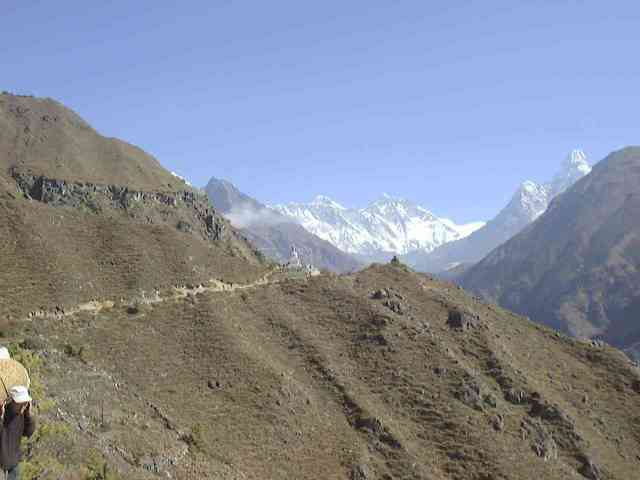 We
were up at 6:30 to pack, eat breakfast and get out on the trail by 8. We
walked through another market part of town, which was crowded even at this
time of day. Occasionally a couple of Yaks would come careering through
the crowd which would part hastily. Just out of town we took a path that
followed the contour of a hill which we had seen the previous day. We
could see the museum with its chorten (religious monument) and prayer
flags flapping in the gentle breeze. The sun began rising in a clear blue
sky and it was the start of another lovely day for trekking, especially as
the going was fairly level. The path was cut into the side of an
extraordinarily steep mountainside so that at times you could look out and
imagine that you were flying down the valley. I had to take care not to
get carried away. We
were up at 6:30 to pack, eat breakfast and get out on the trail by 8. We
walked through another market part of town, which was crowded even at this
time of day. Occasionally a couple of Yaks would come careering through
the crowd which would part hastily. Just out of town we took a path that
followed the contour of a hill which we had seen the previous day. We
could see the museum with its chorten (religious monument) and prayer
flags flapping in the gentle breeze. The sun began rising in a clear blue
sky and it was the start of another lovely day for trekking, especially as
the going was fairly level. The path was cut into the side of an
extraordinarily steep mountainside so that at times you could look out and
imagine that you were flying down the valley. I had to take care not to
get carried away.
As the sun beat onto the mountain slope it brought warm currents of air
wafting up, carrying the scent of pine and herbs. A huge bird of prey made
good use of the updraft to glide effortlessly around the hills, I was
jealous. Far below the turbulent river roared and tumbled in the valley. 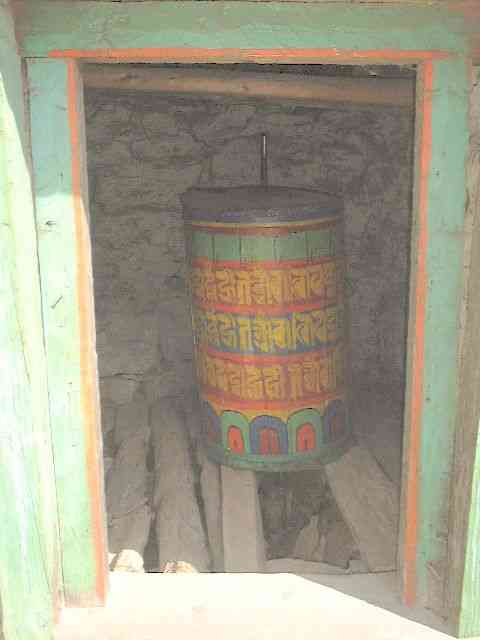 This
path like all others we had been on was busy with porters and beasts of
burden carrying goods not otherwise available in the mountains. One little
man was carrying a stack of 6 wooden doors plus 4 substantial planks of
wood up the rough stone steps that took us 3 hours to climb. The porters
all seem to favour bearing the weight through straps over their head
rather than their shoulders, as we would do (health and safety
permitting). This
path like all others we had been on was busy with porters and beasts of
burden carrying goods not otherwise available in the mountains. One little
man was carrying a stack of 6 wooden doors plus 4 substantial planks of
wood up the rough stone steps that took us 3 hours to climb. The porters
all seem to favour bearing the weight through straps over their head
rather than their shoulders, as we would do (health and safety
permitting).
We stopped for lunch at a little restaurant and had another fine
vegetarian meal. The available ingredients do not seem to be diverse but
the cooks managed to combine them in ever-imaginative ways. After lunch we
descended into the valley and across a wooden bridge built only two months
ago to replace the steel cable suspension bridge that was now languishing
in the turbulent waters. The boulder it was still attached to had been
undermined and rolled into the river.
On the other side we faced a steep, gruelling and relentless climb up the
mountain to our next lodgings at Solukhumbu, Debuche. We must have climbed
about 500 metres up the rough stone steps taking about 3 hours of slow
plodding. Porters and Yaks put us to shame by climbing up past us bearing
their heavy loads. Our excuse was that we were not used to the 70% of
sea-level atmosphere. At the top we came to a colourful monastery with a
big gate guarded by stone lions and containing many bored looking monks.
Curiously we were all distracted by the bakery just next door, which was
rumoured to serve chocolate cake. After our cravings were satisfied (it
was good cake), we walked on down the path for another half hour to the
‘Ama Dablam Garden Lodge Restaurant’ where we would stay for the
night. We had a good Nepalese dinner and played cards to as late as 9
p.m.!
|
Sunday 4th November 2007
InTrees.jpg) The
previous evening Tracy had a bad altitude headache and so we decided to
take a rest day instead of the 5 hour trek to see another monastery and
Everest a little bit closer. It was just glorious just sitting in the
sunshine just watching the porters and trekkers come and go. The
previous evening Tracy had a bad altitude headache and so we decided to
take a rest day instead of the 5 hour trek to see another monastery and
Everest a little bit closer. It was just glorious just sitting in the
sunshine just watching the porters and trekkers come and go. InTrees.jpg) Colourful
little birds sat in the trees nearby and munched on their seeds,
twittering between mouthfuls. Crows cawed lazily in the distance and all
was peaceful. The tranquillity was broken only occasionally by a
helicopter on a rescue mission. Colourful
little birds sat in the trees nearby and munched on their seeds,
twittering between mouthfuls. Crows cawed lazily in the distance and all
was peaceful. The tranquillity was broken only occasionally by a
helicopter on a rescue mission.
We had a choice for lunch so we chose the same Nepali meal that we had
eaten the night before just because we enjoyed it so much.
Jon had also taken the day off, nursing a sore knee, but we were all a
little restless so we decided to go for a short walk. We kept to the
closest thing we could find to a level path so that Jon would not suffer.
It was nice to stroll slowly so that we could take in the scenery. Some of
the trees were shedding their bark in large bronze flakes. Bare branches
were covered in ‘old mans beard’, dangling like light green fluffy
strings and looking like they were decorated for Christmas. Mosses and
lichen covered the rocks, indicating that what atmosphere there was, was
clean.
Further up the path we came across the rest of our party coming back from
their long walk. Jon decided to go back with them but Tracy and I went on
with Sangri, our guide, to see a bridge over a gorge a little further up.
On the way back, clouds rolled up the valley cloaking the place in mist so
when I stood still for a while I could hear nothing at all, a sensation I
hardly ever get to experience. It was so peaceful that I just had to stand
there for a while and soak it all up.
|
Monday 5th November 2007
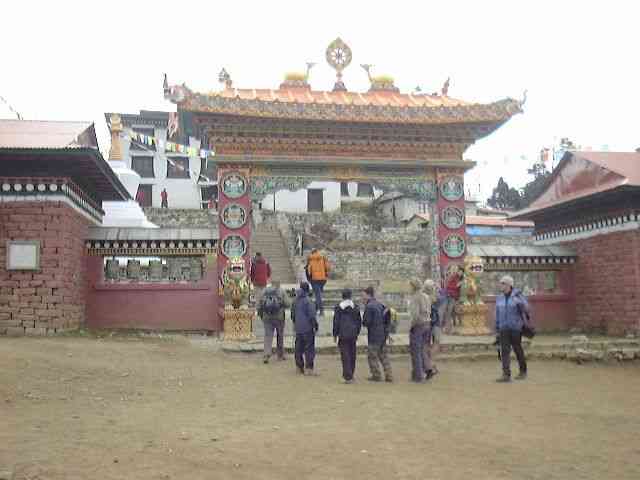 On
every previous day the mornings had greeted us with clear skies so that
the sun warmed the place soon after we started walking. During the
afternoon the clouds would roll in and it would soon cool down. This
morning the clouds were still around from the day before so w On
every previous day the mornings had greeted us with clear skies so that
the sun warmed the place soon after we started walking. During the
afternoon the clouds would roll in and it would soon cool down. This
morning the clouds were still around from the day before so w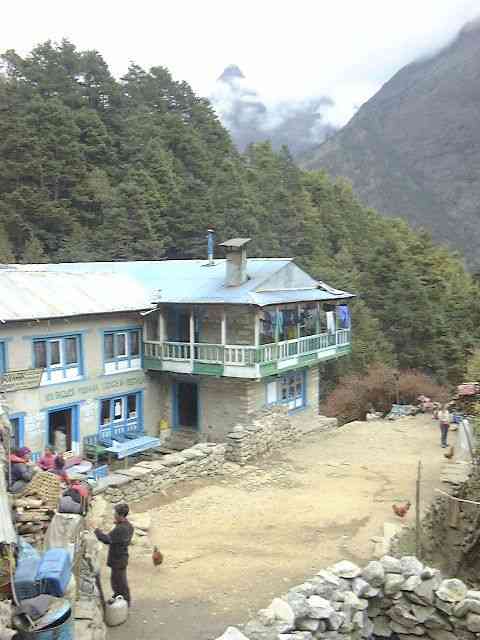 e
had to walk up through the rhododendron forest to Tengbouche Monastery in
cloud. By the time we got there we were at 3870 metres so it is not
surprising that we were in the clouds. We took a look at the monastery and
the Eco centre before taking the steep path down to the river at 3280
metres, a descent of nearly 600m, much of it down steep stone steps, the
same ones that we had climbed up only 2 days before. e
had to walk up through the rhododendron forest to Tengbouche Monastery in
cloud. By the time we got there we were at 3870 metres so it is not
surprising that we were in the clouds. We took a look at the monastery and
the Eco centre before taking the steep path down to the river at 3280
metres, a descent of nearly 600m, much of it down steep stone steps, the
same ones that we had climbed up only 2 days before.
Once over the wooden bridge we climbed back up to Tashinga at 3450m where
we had lunch. The clouds were still with us but the views of the river
tumbling through the gorge were still magnificent. High up on the slopes a
few mountain goats leapt precariously between precipices on slopes that
appeared to be at 80 degrees from the horizontal. Our path wound
inexorably up until we reached Kumjung, a largish village of white walled
and green roofed houses intersperced between empty fields. It was not a
very picturesque place, in fact ‘bleak’ would be a better word. There
was a monastery with a really big prayer wheel but its real claim to fame
was a Yeti head in a glass case, secreted away in a grey steel filing
cabinet. This they brought out to show us on the understanding that tips
would be fed into the moneybox. All I could see was a wig on a ball but I
am sure they knew what they were talking about.
|
Tuesday 6th November 2007
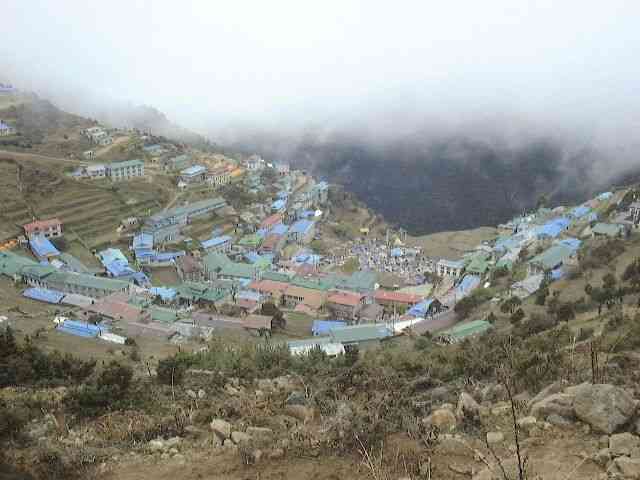 The
village was still in clouds when we set out this morning and we climbed
gently to 3850m. With the clouds obscuring the surrounding mountains you
could easily mistake the mountains for the Yorkshire moors. Other pine
covered sloped could be mistaken for the Alps but glimpses of the sheer,
deep rock faces backed by towering mountains gave the game away. The
village was still in clouds when we set out this morning and we climbed
gently to 3850m. With the clouds obscuring the surrounding mountains you
could easily mistake the mountains for the Yorkshire moors. Other pine
covered sloped could be mistaken for the Alps but glimpses of the sheer,
deep rock faces backed by towering mountains gave the game away.
A group of people were assembling a new wooden building in a space 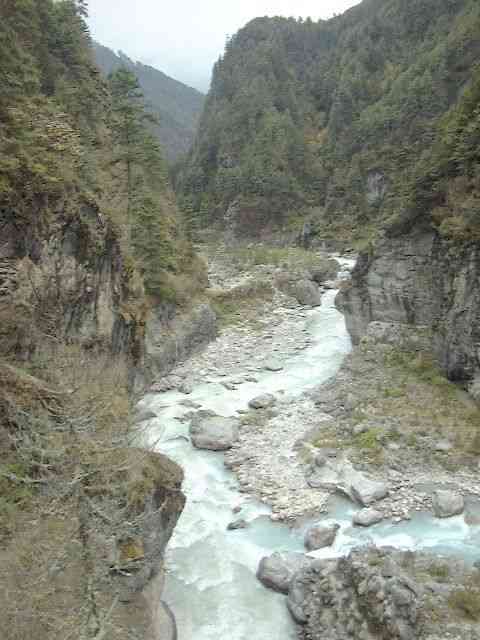 by
their existing stone building. An old lady was struggling up a slippery
slope with five huge beams of wood strapped to her back. As I walked past
I looked down and she had an old trainer on one foot and a small,
colourful Wellington boot that clearly contained no foot at all. by
their existing stone building. An old lady was struggling up a slippery
slope with five huge beams of wood strapped to her back. As I walked past
I looked down and she had an old trainer on one foot and a small,
colourful Wellington boot that clearly contained no foot at all.
Further down the hill we came across an old airstrip, abandoned now
because of the number of accidents, but still partly used by helicopters.
In no time at all we were descending into the bowl shaped hollow that
contained Namche where we had stayed 3 nights before. We even took lunch
at our old lodgings. The afternoon started with a steep descent into the
valley of the Dudh Koshi River. It only took a couple of hours to get down
compared to the 3 hours it took to get up. The next section ran by the
side of the Dudh Koshi River and occasionally across it via wobbly
suspension bridges. Intermittently, an old wooden or steel suspension
bridge could be seen degrading nearby.
We stopped for the night at Manjo Guest House which advertised hot
showers. Our room was even en-suite but the shower was solar and as the
day had been cloudy, the water was cold. The rooms were cold as usual so
we went to the common room. Even there the fire was not yet on and the
door was often left open so we kept our out-door clothes on like the
locals do.
|
Wednesday 7th November 2007
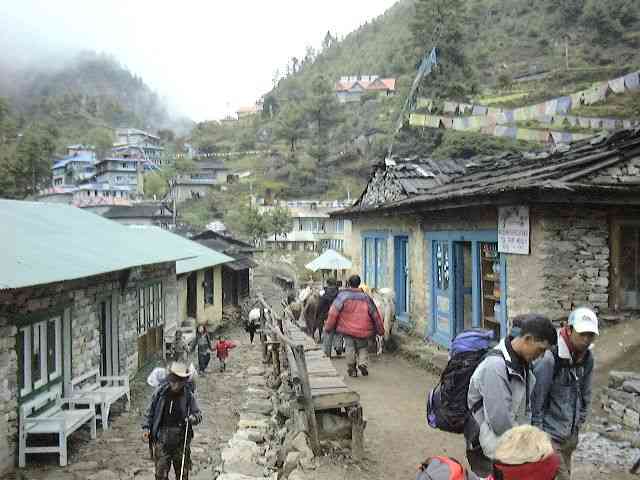 We
are on the home stretch today, We
are on the home stretch today, 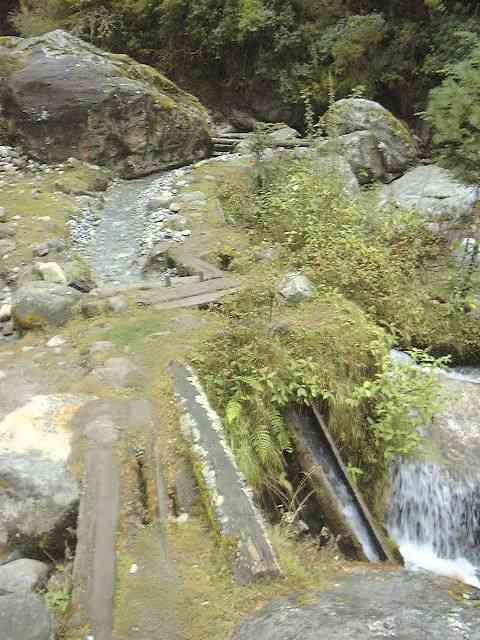 destination
Lukla, where we would stay the night before taking a morning flight back
to Kathmandu. The walking was much easier but still with many ups and
downs along a path of rocks and boulders. There were many places we
recognised from the way up. It was both sad to be leaving the beauty of
the mountains and happy to finish the relentless trekking and get back to
the easy life we knew. During the afternoon it started raining but I guess
we had been fortunate to have dry weather so far. Finally we started to
see planes leaving the airport and knew that it was not far to go. destination
Lukla, where we would stay the night before taking a morning flight back
to Kathmandu. The walking was much easier but still with many ups and
downs along a path of rocks and boulders. There were many places we
recognised from the way up. It was both sad to be leaving the beauty of
the mountains and happy to finish the relentless trekking and get back to
the easy life we knew. During the afternoon it started raining but I guess
we had been fortunate to have dry weather so far. Finally we started to
see planes leaving the airport and knew that it was not far to go.
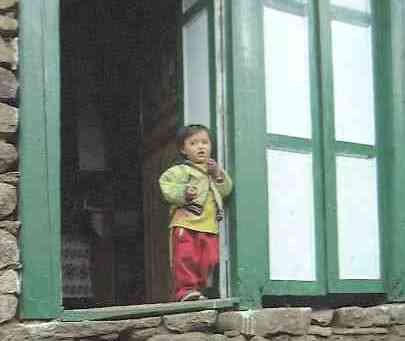 We
stayed at the Himalayan Lodge, which was quite posh compared to what we
had been used to, but its rooms were still panelled in plywood and the
washing facilities were out in the cold night air. We
stayed at the Himalayan Lodge, which was quite posh compared to what we
had been used to, but its rooms were still panelled in plywood and the
washing facilities were out in the cold night air.
All the guides and porters came into the common room for a drink and a few
games of cards. The locals sang trekking songs and a few danced. We
managed a few songs in return but could not really compete.
|
Thursday 8th November 2007
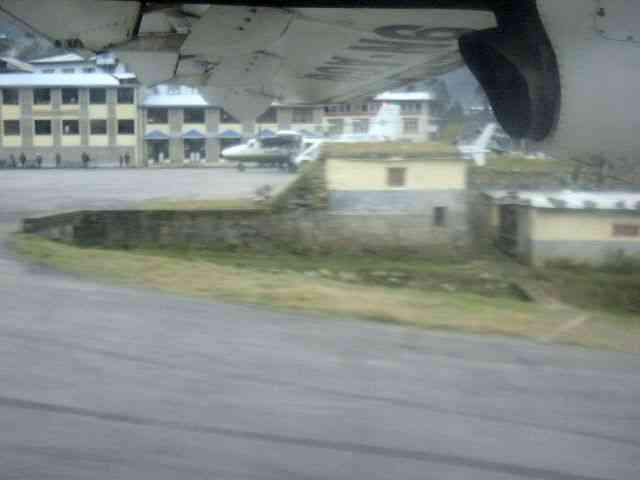 Despite
being lodged right next to the airport we were still up at 5:30 am to
pack, eat breakfast and be at the airport by 7 am. There was a long queue
at security that was going nowhere. Suddenly we were hurried past the
queue and security to the dismay of the other passengers and bundled onto
our little plane, which had hardly stopped moving. After the shortest ever
taxiing ride to the end of the runway, we plummeted down the hill and off
the end of the runway out into oblivion. Thankfully the wings caught the
thin air and we were off between the peaks. Snow dusted mountains passed
to our right and small farms on the hill tops to our left. As we descended
the hill farms grew in size and number and the terraced fields made the
hills look like layer cake. Further down, the occasional walking path
appeared between the farms but it was quite a bit further before they
became wider and tyre tracks appeared. Even in the outskirts of Kathmandu
all the roads were still dirt tracks. Despite
being lodged right next to the airport we were still up at 5:30 am to
pack, eat breakfast and be at the airport by 7 am. There was a long queue
at security that was going nowhere. Suddenly we were hurried past the
queue and security to the dismay of the other passengers and bundled onto
our little plane, which had hardly stopped moving. After the shortest ever
taxiing ride to the end of the runway, we plummeted down the hill and off
the end of the runway out into oblivion. Thankfully the wings caught the
thin air and we were off between the peaks. Snow dusted mountains passed
to our right and small farms on the hill tops to our left. As we descended
the hill farms grew in size and number and the terraced fields made the
hills look like layer cake. Further down, the occasional walking path
appeared between the farms but it was quite a bit further before they
became wider and tyre tracks appeared. Even in the outskirts of Kathmandu
all the roads were still dirt tracks.
In the afternoon we visited the Bouddhanath Stupa, which was a busy but
also peaceful place where locals came to pray and tourists came to shop.
From there we went on to the Pushupati area where cremations are carried
out on the banks of the Bagmati river. The ashes are pushed in and so the
river is now quite polluted. We visited some of the many temples to Lord
Shiva, the god of gods.
|
Friday 9th November 2007
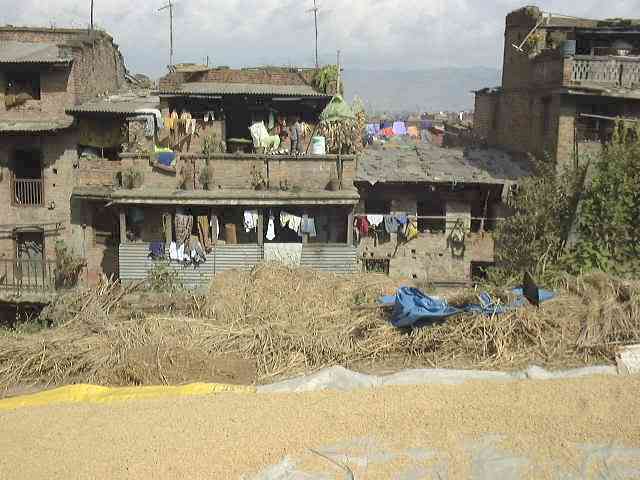 On
this day we went out to Bhaklapur, 12km east of Kathmandu. Built in the
12th century and substantially restored in recent years with help from
Germany, this place is so much nicer to walk around than Kathmandu. This
is mainly due to the absence of heavy vehicles an On
this day we went out to Bhaklapur, 12km east of Kathmandu. Built in the
12th century and substantially restored in recent years with help from
Germany, this place is so much nicer to walk around than Kathmandu. This
is mainly due to the absence of heavy vehicles an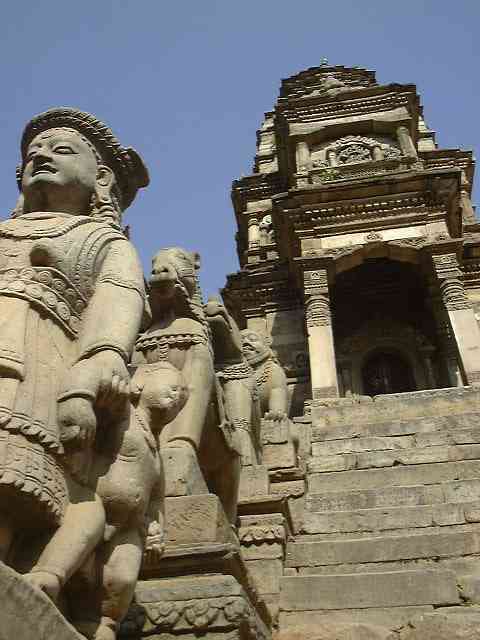 d
the presence of paved streets. The temples and palaces are adorned with
intricate woodcarvings and the trend seems to have spread to other
buildings in the city. Most buildings look very old and in need of repair
but our guide says that the brickwork is rebuilt about every 50 years. The
woodwork is reused because it is hardwood and will last for a few hundred
years. d
the presence of paved streets. The temples and palaces are adorned with
intricate woodcarvings and the trend seems to have spread to other
buildings in the city. Most buildings look very old and in need of repair
but our guide says that the brickwork is rebuilt about every 50 years. The
woodwork is reused because it is hardwood and will last for a few hundred
years.
As we walk down the streets I look into the doors. The interiors look
sooty black and not very inviting. Most people seem to want to be out in
the streets so everywhere is crowded.
We journey there and back by minibus which is a bit like a real life
Whacky Races. In general they drive on the left but when the opposite
carriageway is clear they all try to overtake at once. Sometimes they
overtake three abreast, cutting into each others paths, sounding their
horns and forcing oncoming traffic to perform avoidance manoeuvres while
sounding their own horns in return. On the way there we had passed an
overturned bus 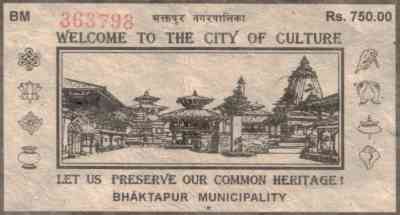 but
by our return it was righted but not yet operational again. I was
surprised not to see or be involved in more accidents but apparently they
are rife. but
by our return it was righted but not yet operational again. I was
surprised not to see or be involved in more accidents but apparently they
are rife.
Our guide is full of information; the population is exploding, assisted by
immigration, the water supply is diminishing, the literary rate has
increased by 47%, family planning is against the religions, education is
expensive but not compulsory. The Nepalese do not arrange their children’s
marriages but the immigrant Indian population do and there is a problem
with young grooms murdering their wives so that they can marry again and
receive another dowry.
|
Saturday 10th November 2007
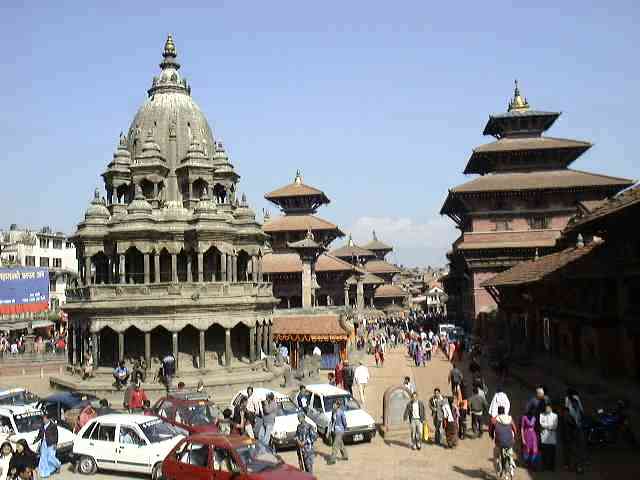 I
did not feel like writing on Sunday and then just forgot to write up
Saturday and Sunday so here are Tracy’s notes instead [Mal]. I
did not feel like writing on Sunday and then just forgot to write up
Saturday and Sunday so here are Tracy’s notes instead [Mal].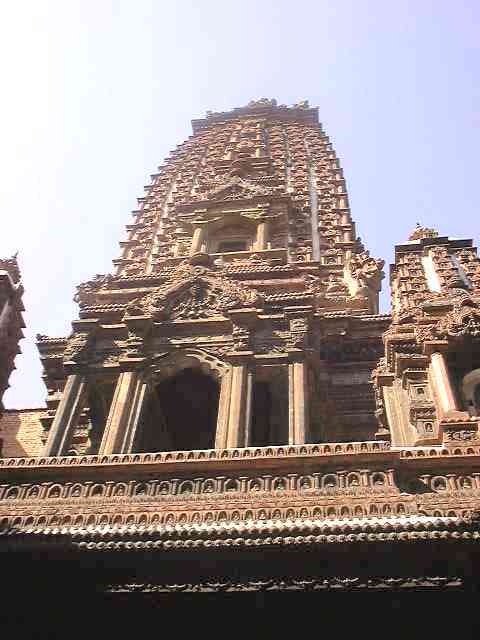
Today we took a trip to Patan, the oldest city in Nepal famous for its
metalwork, woodwork and other fine arts and crafts. Malcolm bought an
amazing singing bowl’ for 2000 Nepalese Rupee (NPR). It is decorated
with animals and looks like it is made from brass. The man in the shop
also gave us a demonstration of the healing properties of a large antique
bowl, which he upturned onto Malcolm’s head and tapped with a hammer.
This process is supposed to cure headaches! Our bowl can help issues such
as high blood pressure. We will try it out on Pat (Malcolm's Mum) when we
get home.
Patan is a temple city. We visited Durbar Square, meaning “Royal
Square”. A lot goes on in these squares; market stalls selling fruit and
vegetables, political broadcasts and trinket sellers. Most of the temples
are “Pagoda” in style. We did visit an Indian style temple, home of
9000 Buddha’s.
Today is still part of the 5-day festival of Diwali. On day 1 they
worship the crow, day 2 the dog, day 3 the cow, 4 the bull and day 5,
brothers. There are lots of people on the streets during the holiday so
when we visited the metal ornaments factory there was no one there to
demonstrate. Sculptures are fashioned in beeswax before being covered in
clay. When the clay is set it is heated and all the wax is drained out
before being replaced by molten metal. The process is called “Lost wax
casting” which ensures each piece is unique and precludes mass
production. Having said that they seemed to have a lot of sculptures in
the showroom, which we were carefully guided into.
Back at the hotel I had iced coffee and a cheese sandwich on the roof
garden terrace. It is a lovely escape from the crowded city with potted
plants and grass but we could not quite escape the tooting car horns,
which constantly fill the air. We relaxed on the terrace before walking to
“Thamel District” to buy a present for Tikendra’s son. It was his
birthday recently.
Then a rest in the hotel before dinner at the Four Seasons. It was a
very disappointing last meal. A lot of the food came out cold. Service was
really slow. It was frustrating today as we are all quite tired due to a
bit of a heavy drinking session the night before. I kept off the alcohol
to give myself a break (I can sometimes).
At the hotel Malcolm presented Tikendra with a card and a collection.
Most of us gave a little speech summoning up our feelings about the trip
and our excellent guide, Tikendra.
|
Sunday 11th November
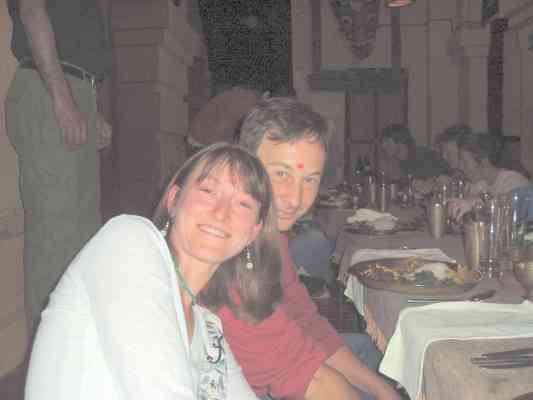 This
is our last day in Nepal. Everyone is feeling really quite tired and just
ready to go home now that we have finished the trekking. Kathmandu is very
polluted and my chest has started to get tight and congested. Oh for the
fresh air of London. This
is our last day in Nepal. Everyone is feeling really quite tired and just
ready to go home now that we have finished the trekking. Kathmandu is very
polluted and my chest has started to get tight and congested. Oh for the
fresh air of London.
The morning was spend packing and shopping. Last minute Christmas
bargains before heading home. We gave some small notes and coins to
disabled beggars on the street. There is no care for them here and their
disabilities are severe. One person had left a baby in the middle of the
pavement in the full heat of the sun and a collecting tin beside the baby.
It’s horrific.
We had lunch at Himalayan Java. It took 1 hour 45 minutes for them to
serve us with 7 pizzas. That was bad enough but then they accused us of
not paying the whole bill. I had seen everyone go and pay so I stood my
ground and argued of course. I won.
As you can see from Malcolm's and I's travelogue it was truly a once in
a lifetime experience. I will never forget this trip and the people
I met. I hope you have enjoyed it with us. |
|
|
|
Index |
|